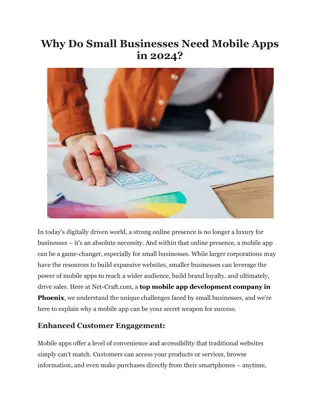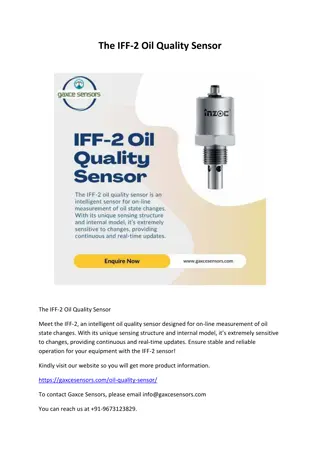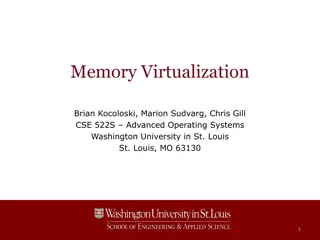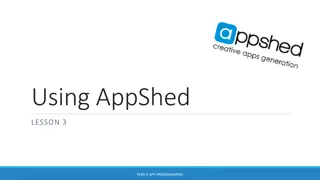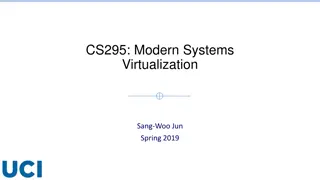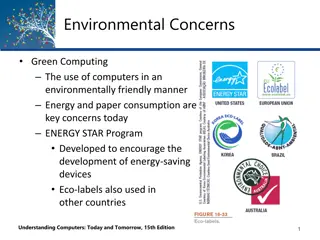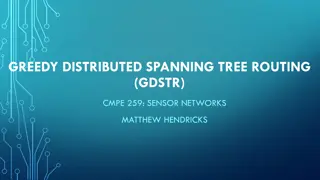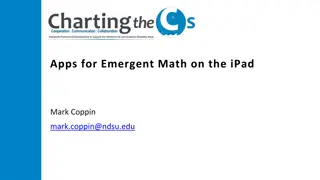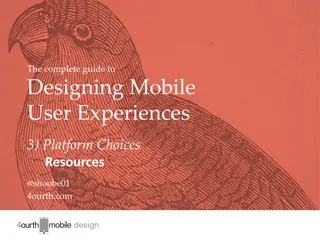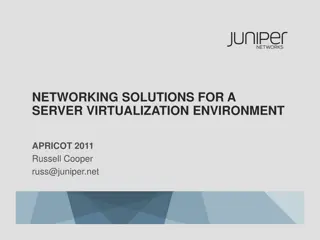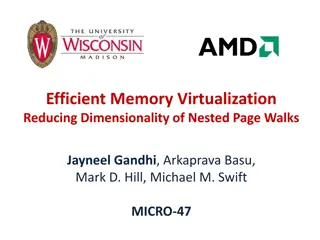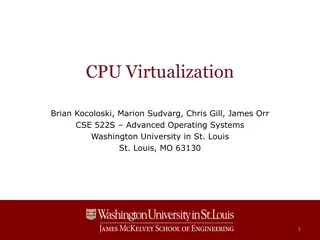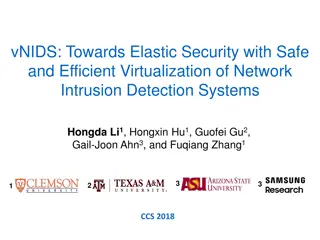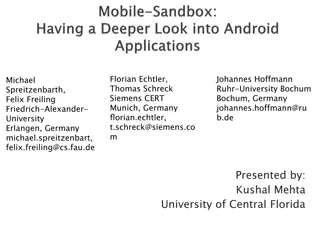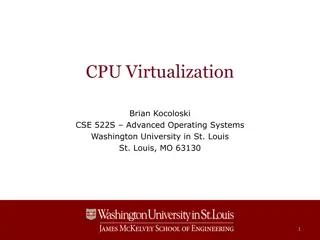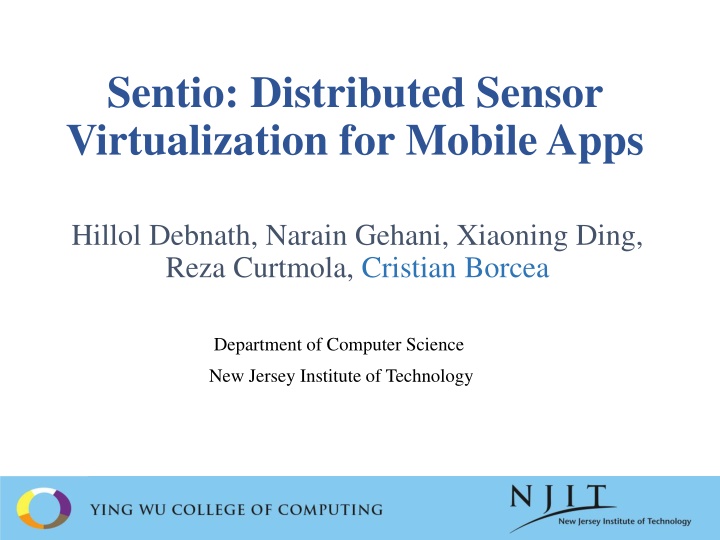
Sentio: Distributed Sensor Virtualization for Mobile Apps
This article discusses Sentio, a distributed sensor virtualization system for mobile apps. It explores the need for seamless sensor access, sensor fusion, and offloading components to the cloud. Sentio provides a high-level view of a personal virtual sensor system (PVSS) that aggregates sensors from various devices. It features a common API for creating virtual sensors, choosing sensing modes, and accessing remote sensor data in real-time without OS modifications. The middleware ensures efficient sensor management and connectivity, adapting to context changes seamlessly.
Download Presentation

Please find below an Image/Link to download the presentation.
The content on the website is provided AS IS for your information and personal use only. It may not be sold, licensed, or shared on other websites without obtaining consent from the author. If you encounter any issues during the download, it is possible that the publisher has removed the file from their server.
You are allowed to download the files provided on this website for personal or commercial use, subject to the condition that they are used lawfully. All files are the property of their respective owners.
The content on the website is provided AS IS for your information and personal use only. It may not be sold, licensed, or shared on other websites without obtaining consent from the author.
E N D
Presentation Transcript
Sentio: Distributed Sensor Virtualization for Mobile Apps Hillol Debnath, Narain Gehani, Xiaoning Ding, Reza Curtmola, Cristian Borcea Department of Computer Science New Jersey Institute of Technology
Goal: Mobile Goal: Mobile A Apps Access Distributed Sensors pps Access Distributed Sensors Seamlessly Seamlessly Mobile apps running on a device may need to Access sensors on other devices in real-time (e.g., mobile health, mobile gaming) Sensor fusion Cross-validation of data Choosing best sensor when several sensors of same type are available Access sensors from cloud when app components are offloaded Existing mobile sensing frameworks do not provide these features Difficult for apps to leverage the collective power of sensors on other devices Limited benefits from offloading context-aware apps that need sensor access 2
Sentio Sentio: High : High- -Level View Level View Distributed middleware that presents mobile apps with a personal virtual sensor system (PVSS) PVSS comprises of all available sensors from all devices (mobiles and IoT) belonging to the user running the app Public sensors belonging to other entities can become part of PVSS 3
Sentio Sentio: Features : Features Common API for apps no matter where they run Offers support for creating individual and composite virtual sensors Provides access to virtual sensors in the same way with access to local sensors Allows programmers to specify a sensing mode, and then map the virtual sensor to the most suitable physical sensor for that mode Modes: accuracy, real-time, energy efficiency Middleware hides low-level communication and sensor management Supports real-time access to remote sensor data Maintains seamless connectivity to the physical sensor even after offloading app components to the cloud Adapts to context changes by re-mapping a virtual sensor to a more suitable physical sensor Does not require modifications to operating system 4
Comparison with Related Work Comparison with Related Work 5
Outline Outline Introduction Programming with Sentio s API Middleware Design Prototype Implementation Experimental Evaluation Conclusion 6
Programming with Programming with Sentio s API follows an event-driven and callback-based asynchronous design For each API function, the app needs to provide a callback function An API call sends a request and returns immediately The middleware handles the request and returns the sensing data to the app by invoking the callback function Sentio s API API Implementing a sensor listener callback 7
Building a Composite Sensor Building a Composite Sensor Composite sensor for climbing combines readings from: Most accurate Heart Rate Monitor and Barometric pressure sensor in PVSS Most energy-efficient Step Counter sensor in PVSS A custom fuse action is implemented by the programmer Warn mountain climbers when they should rest or drink more water at high altitude 8
Middleware Architecture Middleware Architecture Distributed middleware: instances run on every participating device Manages sensor registration, data collection, sensor mapping Instance in the cloud maintains global registry and sensor state Ad hoc networking is used for failover: primary device (smart phone) periodically synchronizes with the cloud instance to be able to take over in case of failures 9
M Middleware Design iddleware Design 10
Design Details Design Details Sensor discovery is done during initialization Each instance builds local registry Cloud instance maintains global registry If app does not specify a sensing mode, Sentio makes the selection by balancing accuracy, latency, and power To reduce jitter, rate controller buffers data points arriving early and uses extrapolation to project data points that arrive late If context changes (e.g., low battery) in sensing provider device Instance in provider raises an alert event Instance in consumer device re-maps virtual sensor to another suitable sensor 11
Prototype and Apps Prototype and Apps Implemented for Android and Android Wear OS 3,127 LoC for the SDK 3,726 LoC for the Android middleware 561 additional LoC for the Android Wear middleware Implemented two proof-of-concept apps (SentioApp and SentioFit) Modified two open source games (Space Shooting and Tilt Control) to use Sentio API Only 6 LoC needed to be modified to use remote accelerometer on smart phone or smart watch Tested using Nexus 6, Nexus 5X, Moto X smart phones and Samsung Gear Live smart watch Bluetooth and WiFi used for data communication Android x86 64-bit VM is used as the cloud entity 12
Sentio Sentio Overhead Overhead Physical sensor on a phone Physical sensor on a watch Measured the difference between the observed sensor sampling period for virtual and physical accelerometer for Space Shooting game Metric quantifies Sentio s overhead Communication is done over WiFi The results show minimal overhead 13
Sentio Sentio Overhead for Offloaded Computation Overhead for Offloaded Computation Measured observed sampling period when Tilt Control game is offloaded to the cloud Accessing sensors from cloud works well The difference in sampling periods is negligible for all sampling rates, except Fastest The difference for Fastest is 5.32ms, which is acceptable in most practical situations 14
Jitter Jitter With data rate controller Without data rate controller Virtual accelerometer is mapped to another phone Data rate controller reduces the jitter significantly 15
Cost of Re Cost of Re- -mapping Virtual Sensor mapping Virtual Sensor Virtual magnetic field sensor re-mapped from smart watch to smart phone The increase only affects the immediately next data point after switching For all practical purposes, skipping one data point is acceptable Data rate controller could smoothen this problem Context prediction can enable proactive switching 16
Conclusion Conclusion Sentio provides a unified view of a personal sensing ecosystem Sentio enables new, distributed, efficient, context-aware mobile apps Apps can use Sentio API to Access virtual sensors in real-time Access the best sensor of a particular type Build composite virtual sensors Sentio middleware Transparently re-maps virtual to physical sensors during context changes Provides seamless sensor connectivity for offloaded code Built prototype in Android and demonstrated low overhead and low latency for apps with tight real-time constraints 17
Thanks! http://cs.njit.edu/~borcea/avatar Acknowledgment: NSF Grants No. CNS 1409523, CNS 1054754, DGE 1565478, and SHF 1617749; DARPA/AFRL Contract No. A8650-15-C-7521



